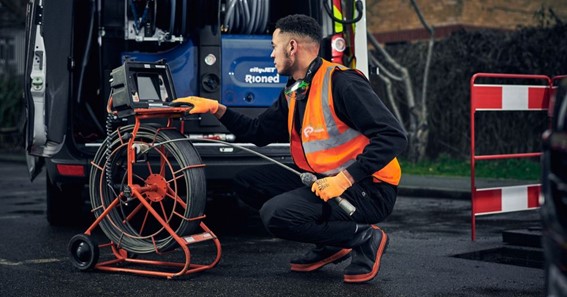Introduction: Blocked drains can wreak havoc on our daily lives, causing inconvenience, property damage, and even health hazards. Fortunately, there are effective methods and advanced technologies available to tackle such issues promptly. In this comprehensive guide, we will delve into the world of drain unblocking, exploring two popular techniques—rodding and high pressure water jetting. We will also discuss the importance of CCTV drain surveys in detecting and addressing drainage problems early on. Let’s dive deeper into these effective solutions for blocked drains.
Understanding the Causes of Blocked Drains: To effectively combat blocked drains, it’s important to understand the root causes behind them. Blocked drains can occur due to a variety of reasons, including:
- Accumulation of Debris: Over time, drains can become clogged with debris such as hair, grease, food particles, soap scum, and foreign objects. These materials can accumulate in the pipes, gradually restricting the flow of water and leading to blockages.
- Tree Root Intrusions: Invasive tree roots are another common cause of blocked drains. Trees seek moisture and nutrients, and their roots can infiltrate small cracks or joints in drain pipes, causing obstructions and even pipe damage.
- Structural Issues: Damaged or deteriorated drain pipes, such as those with cracks, misalignments, or collapses, can hinder the flow of water, leading to blockages. These issues may be the result of aging infrastructure, ground movements, or improper installation.
Unleashing the Power of Rodding: Rodding is a traditional yet effective method used to tackle blocked drains. It involves using specialized rods that are manually inserted into the drain to dislodge and remove blockages. Here’s how rodding works:
- Assessing the Blockage: The drainage engineer begins by assessing the nature and location of the blockage. This helps determine the appropriate rod type and size required for the task.
- Inserting the Rods: The selected rods are carefully maneuvered into the drain, applying pressure to break down the obstruction. The engineer skillfully navigates the rods, ensuring thorough coverage of the affected area.
- Removing the Blockage: By manipulating the rods, the engineer dislodges the blockage, allowing water to flow freely through the drain once again. Depending on the severity of the blockage, multiple attempts may be required to achieve optimal results.
click Here – Elevate Your Style Quotient with Elegance Net Sarees
Harnessing the Force of High Pressure Water Jetting: When faced with more stubborn blockages or extensive debris buildup, high pressure water jetting proves to be a highly effective solution. This technique involves using powerful jets of water to dislodge and flush away the blockages. Here’s how high pressure water jetting works:
- Assessing the Blockage: The drainage engineer evaluates the blockage and determines the appropriate water pressure and nozzle configuration required for effective removal.
- Jetting the Drain: Using specialized equipment, the engineer directs highly pressurized water into the drain. The force of the water jets breaks down the obstruction, while the water flow flushes away the debris, restoring the normal flow of water.
- Thorough Cleaning: High pressure water jetting not only clears the blockage but also effectively cleans the interior walls of the pipes. The force of the water removes accumulated debris, scale, grease, and other residues, enhancing the overall efficiency of the drainage system.
The Role of CCTV Drain Surveys: While rodding and high pressure water jetting are valuable techniques for addressing immediate blockages, it is equally important to identify and resolve underlying issues to prevent future problems. This is where CCTV drain surveys play a vital role. By employing advanced CCTV technology, drainage specialists can conduct comprehensive inspections of the drainage system, providing valuable insights into its condition. Here’s how CCTV drain surveys can help:
- Early Detection of Issues: CCTV drain surveys allow for the early detection of potential problems. By closely examining the high-definition footage captured by the CCTV cameras, experts can identify signs of pipe damage, blockages, tree root intrusions, or other issues that may cause future blockages.
- Accurate Diagnosis: The detailed footage obtained through CCTV surveys provides a precise understanding of the condition of the drainage system. This allows drainage engineers to accurately diagnose problems and recommend appropriate solutions. Whether it’s repairing damaged pipes, addressing tree root intrusions, or implementing preventive measures, an accurate diagnosis ensures targeted and effective actions.
- Efficient Planning: Armed with a clear view of the drainage system’s condition, experts can devise the most efficient and targeted solutions. The information obtained from the CCTV drain survey helps in planning repairs or maintenance activities, ensuring that they are carried out with precision and minimal disruption.
- Preventive Maintenance: CCTV drain surveys are not limited to addressing existing blockages. They also assist in proactive maintenance by identifying potential issues before they become disruptive or costly problems. Regular surveys can help maintain the health of your drainage system and prevent blockages from occurring in the first place.
Conclusion: When faced with the frustration of blocked drains, it’s essential to choose the right methods and technologies to address the issue effectively. Rodding and high pressure water jetting offer immediate solutions to clear blockages and restore flow. However, to prevent future complications, it’s crucial to conduct CCTV drain surveys. These surveys provide in-depth insights into the condition of the drainage system, enabling early detection and accurate diagnosis of potential issues. By utilizing a combination of these effective techniques, you can ensure the smooth flow of your drains and enjoy a healthy and efficient drainage system.
Don’t let blocked drains continue to be a source of frustration—seek professional assistance, implement preventive measures, and keep your drainage system running smoothly.

